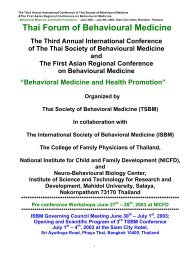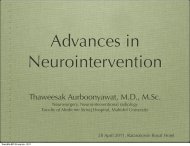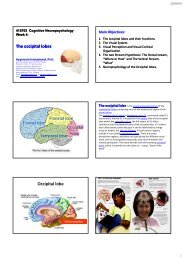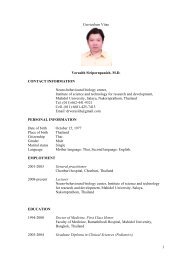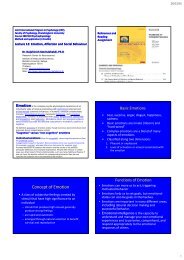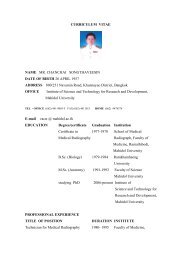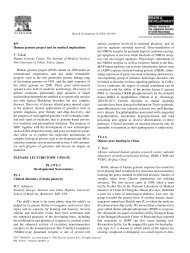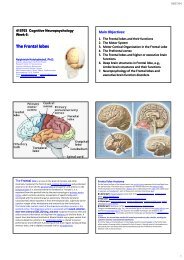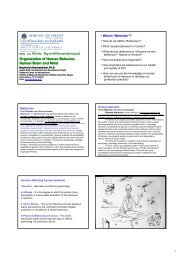1 Development and Organization Development and Organization of ...
1 Development and Organization Development and Organization of ...
1 Development and Organization Development and Organization of ...
You also want an ePaper? Increase the reach of your titles
YUMPU automatically turns print PDFs into web optimized ePapers that Google loves.
Classical conditioning (Pavlovian or respondent conditioning, Pavlovian<br />
reinforcement) is a form <strong>of</strong> conditioning that was first demonstrated by Ivan Pavlov (1927). [1]<br />
The typical procedure for inducing classical conditioning involves presentations <strong>of</strong> a neutral<br />
stimulus along with a stimulus <strong>of</strong> some significance, the "unconditioned stimulus". The neutral<br />
stimulus could be any event that does not result in an overt behavioral response from the<br />
organism under investigation. Conversely, presentation <strong>of</strong> the significant stimulus necessarily<br />
evokes an innate, <strong>of</strong>ten reflexive, response. Pavlov called these the unconditioned stimulus<br />
(US) <strong>and</strong> unconditioned response (UR), respectively. If the neutral stimulus presented along<br />
with the unconditioned stimulus, it would become a conditioned stimulus (CS). If the CS <strong>and</strong><br />
the US are repeatedly paired, eventually the two stimuli become associated <strong>and</strong> the organism<br />
begins to produce a behavioral response to the CS. Pavlov called this the conditioned<br />
response (CR).<br />
Popular forms <strong>of</strong> classical conditioning that are used to study neural structures <strong>and</strong> functions<br />
that underlie learning <strong>and</strong> memory include fear conditioning, eyeblink conditioning, <strong>and</strong> the<br />
foot contraction conditioning <strong>of</strong> Hermissenda crassicornis.<br />
The classical conditioning involved the salivary conditioning <strong>of</strong> Pavlov's dogs. During his<br />
research on the physiology <strong>of</strong> digestion in dogs, Pavlov noticed that, rather than simply<br />
salivating in the presence <strong>of</strong> meat powder (an innate response to food that he called the<br />
unconditioned response), the dogs began to salivate in the presence <strong>of</strong> the lab technician who<br />
normally fed them. Pavlov called these psychic secretions. From this observation he predicted<br />
that, if a particular stimulus in the dog's surroundings were present when the dog was<br />
presented with meat powder, then this stimulus would become associated with food <strong>and</strong><br />
cause salivation on its own. In his initial experiment, Pavlov used a bell to call the dogs to their<br />
food <strong>and</strong>, after a few repetitions, the dogs started to salivate in response to the bell.<br />
Trial <strong>and</strong> Error<br />
ลองถูก-ผิด<br />
B.F. Skinner<br />
12



